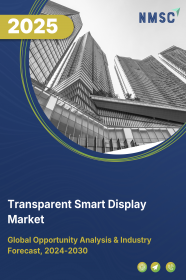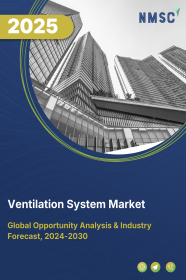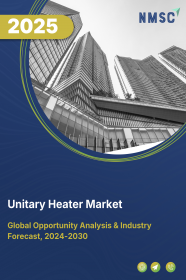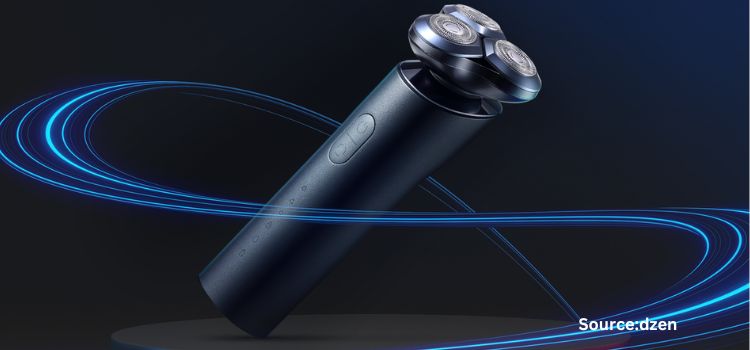
Transparent Smart Display Market by Technology (OLED, LCD, LED, Others), Display Size (Less than 30", 30-60", More than 60"), Application (HUDs, HMDs, Digital Signage, Video Walls, Smart Appliances, Wearables, Others), and End-User (Automotive, Consumer Electronics, Healthcare, Aerospace & Defense, Hospitality, Others) – Global Opportunity Analysis and Industry Forecast, 2024–2030
US Tariff Impact on Transparent Smart Display Market
Trump Tariffs Are Reshaping Global Business
Transparent Smart Display Market Overview
The Transparent Smart Display Market size was valued at USD 1.23 billion in 2023 and is predicted to reach USD 3.04 billion by 2030 with a CAGR of 13.8% from 2024-2030.
The transparent smart display market also known as see-through display refers to the industry that focuses on the development of display technologies that allows users to see through the screen while continuously displaying digital content. These advanced transparent displays are utilized in a variety of applications, including retail, automotive, advertising, and augmented reality environments.
The primary advantage of these transparent displays lies is to merge the digital and physical worlds, providing innovative ways to present information and engage consumers without obstructing their view.
Thus, by using these displays, businesses create visually appealing and interactive experiences, enhancing consumer engagement and providing real-time information in a seamless manner. The market also supports the growing demand for smart, connected, and innovative visuals communications tools, driving advancements in both consumers and commercial applications.
Therefore, the evolving technological advancements smart transparent displays become increasingly important in shaping and enhancing our interactions with everyday life.
Market Dynamics and Trends
The global transparent smart display market is experiencing significant growth due to continuous advancements in display technologies such as OLED, LED, and LCD. These innovations are improving the performance while reducing costs and making transparent displays more accessible for a wide range of applications. For example, in January 2024, LG launched the world's first wireless transparent OLED TV.
This advanced TV features a transparent screen that is mounted on walls or placed on tables, providing flexibility for modern living spaces. The utilization of this cutting-edge OLED technology delivers superior image quality with deep blacks and vibrant colors, thereby further driving interest and expansion in the market.
Moreover, the rising automotive sector necessitates the demand for advanced technologies including HUDs that accelerates the demand for transparent smart displays. Automotive manufacturers are increasingly integrating these transparent displays into windshields and windows, to improve safety and user experience by providing real-time information, navigation, and augmented reality features.
According to the latest report published by the International Organization of Motor Vehicle Manufacturers, approximately 92.72 billion units of vehicles were sold in 2023, up from 82.87 billion units in 2022 reflecting a notable growth of around 12%. Consequently, this surge in vehicle sales propels the demand for see-through smart displays, that in turn fuels the growth of the market.
Additionally, the increasing investments in the healthcare sector are fuelling the growth of transparent smart display market. The adoption of these see-through smart displays for advanced medical imaging, patient monitoring, and interactive information displays is changing patient care and improving diagnostic accuracy.
According to the latest report by the India Brand Equity Foundation (IBEF), the healthcare spending in India is experiencing significant growth with a projection to expand from USD 110 billion in 2016 to USD 638 billion by 2025.
Further, the latest report of the Peter G. Foundation report states that the U.S. healthcare spending reached to USD 4.5 trillion that accounts an average to USD 13,493 per person in 2022. Thus, the growing investments in healthcare sectors across the globe is accelerating the integration of see-through smart displays, thereby leading to notable advancements in medical technology and patient outcomes.
However, high cost associated with the productions of the transparent smart displays as it involves advanced technologies and materials, retrains the growth of the market.
On the contrary, the introduction of MicroLED technology into transparent smart displays is expected to create ample future opportunities. MicroLED provides higher brightness, improved contrast ratios, and extended lifespans by enhancing the overall user experience.
For instance, in January 2024, Samsung launched its transparent MicroLED display that blurs the boundaries between content and reality with its crystal-clear, glass-like displays that provides a more vivid and immersive viewing experience. Therefore, the introduction of MicroLED technology into the see-through smart display market will stimulate the market growth by attracting new applications and industries, creating lucrative market opportunities.
Market Segmentation and Scope of Study
The transparent smart display market report is segmented by technology, display size, application, end user and region. On the basis of technology, the market is divided into OLED (Organic Light Emitting Diode), LCD (Liquid Crystal Display), LED (Light Emitting Diode), and others. On the basis of display size, the market is categorized into less than 30 inches, between 30-60 inches, and more than 60 inches.
On the basis of application, the market is segmented into head-up display (HUD), head-mounted display (HMD), digital signage, transparent video walls, smart appliances, wearable devices, and others. On the basis of end user, the market is classified into automotive, consumer electronics, healthcare, aerospace & defense, hospitality, and others. Regional breakdown and analysis of each of the aforesaid segments includes regions comprising of North America, Europe, Asia-Pacific, and RoW.
Geographical Analysis
Asia-Pacific holds the dominating in the transparent smart display market share and is expected to continue its dominance throughout the forecast period. This is attributed to the presence of key market players such as Lenovo Group Limited, Samsung Electronics Co., Ltd., and LG Display Co., Ltd. that are brining innovations, advanced technologies, and substantial investments to the sector.
Their competitive strategies and continuous development by introducing new products and enhancing existing technologies, fosters a dynamic market environment. For instance, in February 2024, Lenovo launched its innovative ThinkBook laptops that comes with the futuristic ThinkBook transparent display laptop concept. The laptop features a 17.3" MicroLED transparent display that merges digital and physical interactions. Consequently, such advancements reflect the growing interest and investments in see-through smart displays and also sets a standard for future in the transparent smart display market growth.
Moreover, the growing automotive industry necessitates advanced technologies such as HUDs and infotainment systems to enhance both vehicle functionality and user experience, further propelling the growth of the market. According to latest report published by the Our World in Data, the number of vehicles sold in 2023 were about 76.67 million units an increase of 5% from 72.86 million units in 2022. The transparent smart displays provide critical information to drivers without obstructing their view that improves safety and add a futuristic touch to vehicles. Thus, this growing transparent smart display market demand within the automotive sector is further accelerating the expansion of see-through display market in the Asia-Pacific region.
On the other hand, the North America region is expected to show a steady rise in the transparent smart displays growth owing to the rising government investment in healthcare sector that requires these displays for various applications including medical imaging. These see-through displays provide clear, real-time visualization of patient data and diagnostic images that enhances the efficiency and effectiveness of medical professionals.
According to the latest report from the Canadian Medical Association (CMA), Canada healthcare spending reached USD 344 billion in 2023. This accounts to an average expenditure of USD 8,740 per person and is about 12.1% of Gross Domestic Product (GDP). Consequently, such increasing investments in healthcare infrastructure reflects the regions commitment towards improving medical practices and patient’s outcome thereby fueling the demand for see-through smart displays in North America.
Furthermore, the growing adoption of smart wearables in the region as consumers increasingly seek wearable devices with advanced features including transparent smart displays is significantly driving the growth of the market. These displays provide enhanced aesthetics and functionality that enables more innovative and interactive user experiences.
According to the latest report published by the National Heart, Lung, and Blood Institute (NIH), approximately 30% of the U.S. adults utilizes wearable devices for their health tracking. Therefore, this surge in reliance on wearable technologies fuels the demand for see-through smart displays, that drives the market growth across various sectors in the region.
Competitive Landscape
Various key players operating in the transparent smart displays industry include Samsung Electronics Co., Ltd., LG Display Co., Ltd., Panasonic Holdings Corporation, Leyard Optoelectronic, Planar Systems, Inc., BOE Technology Group Co., Ltd., Kent Optronics, Inc., Japan Display Inc., Crystal Display Systems Ltd, and Nexnovo Technology Co., Ltd, and others. These companies are opting various strategies including product launches to maintain their dominance in the industry.
For instance, in January 2024, LG Display Co., Ltd. announced their Signature OLED T, set to launch in the second half of 2024. It will feature a 77-inch OLED display that switch between transparent and opaque modes. The transparent mode displays art, videos, data such as news and weather allowing users to see through the screen to the rest of the room.
Further, in January 2024, Samsung launched its new 110-inch Micro LED 4K TV. The transparent Micro LED technology is a versatile solution for homes and businesses with exceptional picture quality and a seamless, bezel-less design.
Moreover, in January 2024, BOE Technology Group Co., Ltd. launched the world's first 49-inch transparent OLED display with brilliant color effect and permeability that is suitable for smart transportation scenarios.
Key Benefits
-
The report provides quantitative analysis and estimations of the transparent smart display market from 2024 to 2030, which assists in identifying the prevailing market opportunities.
-
The study comprises a deep-dive analysis of the current and future transparent smart display market trends to depict prevalent investment pockets in the industry.
-
Information related to key drivers, restraints, and opportunities and their impact on the transparent smart display market is provided in the report.
-
Competitive analysis of the players, along with their market share is provided in the report.
-
SWOT analysis and Porters Five Forces model is elaborated in the study.
Value chain analysis in the market study provides a clear picture of roles of stakeholders.
Transparent Smart Display Market Key Segments
By Technology
-
OLED (Organic Light Emitting Diode)
-
LCD (Liquid Crystal Display)
-
LED (Light Emitting Diode)
-
Others
By Display Size
-
Less than 30 inches
-
Between 30-60 inches
-
More than 60 inches
By Application
-
Head-up Display (HUD)
-
Head-Mounted Display (HMD)
-
Digital Signage
-
Transparent Video Walls
-
Smart Appliances
-
Wearable Devices
-
Others
By End-User
-
Automotive
-
Consumer Electronics
-
Healthcare
-
Aerospace & Defense
-
Hospitality
-
Others
By Region
-
North America
-
The U.S.
-
Canada
-
Mexico
-
-
Europe
-
The UK
-
Germany
-
France
-
Italy
-
Spain
-
Denmark
-
Netherlands
-
Finland
-
Sweden
-
Norway
-
Russia
-
Rest of Europe
-
-
Asia-Pacific
-
China
-
Japan
-
India
-
South Korea
-
Australia
-
Indonesia
-
Singapore
-
Taiwan
-
Thailand
-
Rest of Asia-Pacific
-
-
RoW
-
Latin America
-
Middle East
-
Africa
-
Key Players
-
Samsung Electronics Co., Ltd.
-
LG Display Co., Ltd.
-
Panasonic Holdings Corporation
-
Leyard Optoelectronic
-
Planar Systems, Inc.
-
BOE Technology Group Co., Ltd.
-
Kent Optronics, Inc.
-
Japan Display Inc.
-
Crystal Display Systems Ltd.
-
Nexnovo Technology Co, Ltd.
REPORT SCOPE AND SEGMENTATION:
|
Parameters |
Details |
|
Market Size in 2023 |
USD 1.23 Billion |
|
Revenue Forecast in 2030 |
USD 3.04 Billion |
|
Growth Rate |
CAGR of 13.8% from 2024 to 2030 |
|
Analysis Period |
2023–2030 |
|
Base Year Considered |
2023 |
|
Forecast Period |
2024–2030 |
|
Market Size Estimation |
Billion (USD) |
|
Growth Factors |
|
|
Countries Covered |
28 |
|
Companies Profiled |
10 |
|
Market Share |
Available for 10 companies |
|
Customization Scope |
Free customization (equivalent to up to 80 working hours of analysts) after purchase. Addition or alteration to country, regional, and segment scope. |
|
Pricing and Purchase Options |
Avail customized purchase options to meet your exact research needs. |

















 Speak to Our Analyst
Speak to Our Analyst





















